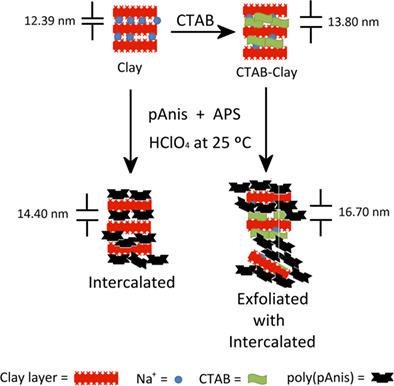当前位置:
X-MOL 学术
›
Polym. Compos.
›
论文详情
Our official English website, www.x-mol.net, welcomes your
feedback! (Note: you will need to create a separate account there.)
A comparative study on surfactant cetyltrimethylammoniumbromide modified clay‐based poly(p‐anisidine) nanocomposites: Synthesis, characterization, optical and electrochemical properties
Polymer Composites ( IF 4.8 ) Pub Date : 2021-01-12 , DOI: 10.1002/pc.25941 Nadia Boutaleb 1, 2 , Faiza Chouli 3 , Abdelghani Benyoucef 1 , Fatima Z. Zeggai 4 , Khaldoun Bachari 4
Polymer Composites ( IF 4.8 ) Pub Date : 2021-01-12 , DOI: 10.1002/pc.25941 Nadia Boutaleb 1, 2 , Faiza Chouli 3 , Abdelghani Benyoucef 1 , Fatima Z. Zeggai 4 , Khaldoun Bachari 4
Affiliation

|
The preparation of hybrid materials, namely poly(p‐anisidine)@Clay (poly(pAnis)@Clay) and poly(p‐anisidine)@cetyltrimethylammoniumbromide‐Clay (poly(pAnis)@CTAB‐Clay), prepared by oxidative polymerization process is presented. The formation of nanomaterials has been confirmed by XRF, XPS, FT‐IR, and UV–Vis spectroscopy. Interestingly, the study of the optical band gap energy (Eg) evince lowest value of 3.22 eV for poly(pAnis)@CTAB‐Clay compared to poly(pAnis)@Clay with 3.26 eV. XRD results demonstrate that the intercalation of the poly(pAnis) into the Clay was confirmed by the increased interlayer spacing, the exfoliation and intercalation forms were affirmed in the TEM images. In addition, the electrochemical behavior indicates that the prepared nanocomposites are electroactive. These results are heartening in respect with the objective to utilize them in the field of technology and research related to the photovoltaics application.
中文翻译:

表面活性剂十六烷基三甲基溴化铵改性粘土基聚对茴香胺纳米复合材料的比较研究:合成,表征,光学和电化学性质
通过氧化聚合工艺制备杂化材料,即聚对茴香胺@粘土(poly(pAnis)@Clay)和聚对苯胺嘧啶@十六烷基三甲基溴化铵-粘土(poly(pAnis)@ CTAB-Clay)。被表达。XRF,XPS,FT-IR和UV-Vis光谱已确认了纳米材料的形成。有趣的是,对光学带隙能量(E g),从而使poly(pAnis)@ CTAB-Clay的最低值为3.22 eV,而poly(pAnis)@Clay的值为3.26 eV。X射线衍射结果表明,聚(pAnis)插入到粘土中已被增加的层间距证实,在TEM图像中确认了剥落和插入形式。另外,电化学行为表明所制备的纳米复合材料是电活性的。就在与光伏应用有关的技术和研究领域中利用它们的目标而言,这些结果令人鼓舞。
更新日期:2021-01-12
中文翻译:

表面活性剂十六烷基三甲基溴化铵改性粘土基聚对茴香胺纳米复合材料的比较研究:合成,表征,光学和电化学性质
通过氧化聚合工艺制备杂化材料,即聚对茴香胺@粘土(poly(pAnis)@Clay)和聚对苯胺嘧啶@十六烷基三甲基溴化铵-粘土(poly(pAnis)@ CTAB-Clay)。被表达。XRF,XPS,FT-IR和UV-Vis光谱已确认了纳米材料的形成。有趣的是,对光学带隙能量(E g),从而使poly(pAnis)@ CTAB-Clay的最低值为3.22 eV,而poly(pAnis)@Clay的值为3.26 eV。X射线衍射结果表明,聚(pAnis)插入到粘土中已被增加的层间距证实,在TEM图像中确认了剥落和插入形式。另外,电化学行为表明所制备的纳米复合材料是电活性的。就在与光伏应用有关的技术和研究领域中利用它们的目标而言,这些结果令人鼓舞。











































 京公网安备 11010802027423号
京公网安备 11010802027423号